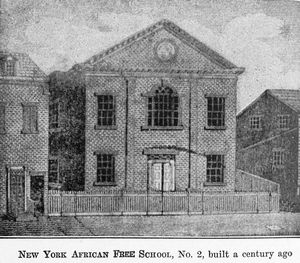James McCune Smith
Template:Infobox revolution biography
Dr. James McCune Smith (April 18,1813 – November 17, 1865) was the first African-American to run a pharmacy in the United States. He was also the first to practice medicine, and the first Black person in the world to earn a medical degree.
Smith was also a prominent abolitionist and author. Over the course of his life, Smith wrote forcefully in refutation of some of the most common misconceptions about race, intelligence, medicine, and society in general. His friends and colleagues in this movement were often famous, and included the noted abolitionist Fredrick Douglass.
Birth and Parentage
Smith was born on April 18, 1813 in New York City.[1] By most accounts, Smith's father was freed through the Emancipation Act adopted in New York. However, the New York Historical Society identifies Smith's father as a White merchant.[2] His mother was an African slave who worked her way out of bondage. Smith is often quoted as saying that he was born "the son of a self-emancipated bond-woman".[3]
Education

Smith attended the African Free School, where he was an "exceptionally bright student" .[4] In the course of his studies, he was tutored by Rev. Peter Williams, Jr., an Episcopalian minister at St. Joseph's Church in New York City, and also a graduate of the African Free School. Upon graduation, Smith tried to attend several American colleges, but was denied admission by each of them due to racial discrimination.
Williams suggested that Smith attend the University of Glasgow in Scotland.[5] Williams helped Smith raise money for his trip to Scotland and his subsequent education there. Smith was accepted to the University, where he later graduated at the top of his class. He obtained a bachelor's degree in 1835, a master's degree in 1836, and a medical degree in 1837. He then traveled from Glasgow to Paris to complete a brief internship.[6]
Career in medicine
Upon his return to New York City in 1837, Smith became the United State's first professionally trained African-American physician. His practice spanned 25 years. In 1846, he was appointed the only doctor of Free Negro Orphan Asylum. He worked there for over twenty years.[7] He also opened what has been called the first black pharmacy in the United States, which was located on West Broadway.[8]
Abolitionist Movement
While in Scotland, Smith was a member of the Glasgow Emancipation Society.[9] When he returned to New York, he became a member of the American Anti-Slavery Society. In 1850, he was one of the key organizers of New York's resistance to the Fugitive Slave Act as a member of the Committee of Thirteen. During the mid 1850s, he helped Frederick Douglass to establish the National Council of Colored People.[10]
Essays and writings
Smith was a prolific writer and essayist. Among other works, he wrote the introduction to Fredrick Douglass' second autobiography, My Bondage and My Freedom (1855), which constituted an important move away from seeking approval and authentication from white abolitionists in African-American accounts of slavery. In this introduction, he writes:
"...the worst of our institutions, in its worst aspect, cannot keep down energy, truthfulness, and earnest struggle for the right."[11]
Smith also wrote from the view of a trained doctor. The physician and abolitionist wrote an essay that refuted the theories of race in Thomas Jefferson's "Notes on the State of Virginia"[12] He also wrote essays that rejected phrenology and homeopathy. Yet another essay critiqued the U.S. Census of 1840 on racial and statistical grounds.
Death
In 1863, Smith became a professor of anthropology at Wilberforce College (now Wilberforce University), though he was ill at the time with a heart condition.[13] Wilberforce College is located in Ohio, and is the oldest African-American college in the United States.
Smith died on November 17, 1865 at the age of 52. His death occurred just a few weeks after congressional passage of the Thirteenth Amendment to the Constitution of the United States, which abolished slavery throughout the Country. He died leaving a wife and five children.[14]
Published essays by Smith
- "A Lecture on the Haitian Revolution" (1841)
- "The Destiny of the People of Color"
See also
- Peter Williams, Jr.
- African-American
- African Free School
- New York Manumission Society
- University of Glasgow
- abolitionism
- Slavery
- Thirteenth Amendment to the United States Constitution
- Fredrick Douglass
- List of African American firsts
References
- ^ http://www.pbs.org/wgbh/amex/partners/early/e_pioneers_smith.html
- ^ http://www.nydivided.org/popup/People/JamesMcCuneSmith.php
- ^ Blane, Dougla. "The education and medical practice of Dr. James McCune Smith". University of Glasgow. Retrieved 2006-12-10.
- ^ https://www.nyhistory.org/web/afs/bios/james-mccune-smith.html
- ^ http://www.gla.ac.uk:443/avenue/32/na2.html
- ^ http://www.biography.com/search/article.do?id=9486894
- ^ http://www.biography.com/search/article.do?id=9486894
- ^ http://www.pbs.org/wgbh/amex/partners/early/e_pioneers_smith.html
- ^ http://www.gla.ac.uk:443/avenue/32/na2.html
- ^ https://www.nyhistory.org/web/afs/bios/james-mccune-smith.html
- ^ http://www.pbs.org/wgbh/amex/partners/early/e_pioneers_smith.html
- ^ http://www.ncbi.nlm.nih.gov/entrez/query.fcgi?cmd=Retrieve&db=PubMed&list_uids=12911258&dopt=Abstract
- ^ http://americanabolitionist.liberalarts.iupui.edu/smithjm.htm
- ^ http://www.pbs.org/wgbh/amex/partners/early/e_pioneers_smith.html
External links
- "African Free School Bios: James McCune Smith". Retrieved 2006-12-21.
- "African American Medical Pioneers: James McCune Smith". Retrieved 2006-12-10.
- "Created Equal". Retrieved 2006-12-10.
- "The education and medical practice of Dr. James McCune Smith". Retrieved 2006-12-10.
- "James McCune Smith". Retrieved 2006-12-10.
- "New York Divided: James McCune Smith". Retrieved 2006-12-21.
- "James McCune Smith". Retrieved 2006-12-24.
- "James M. Smith Community School".
